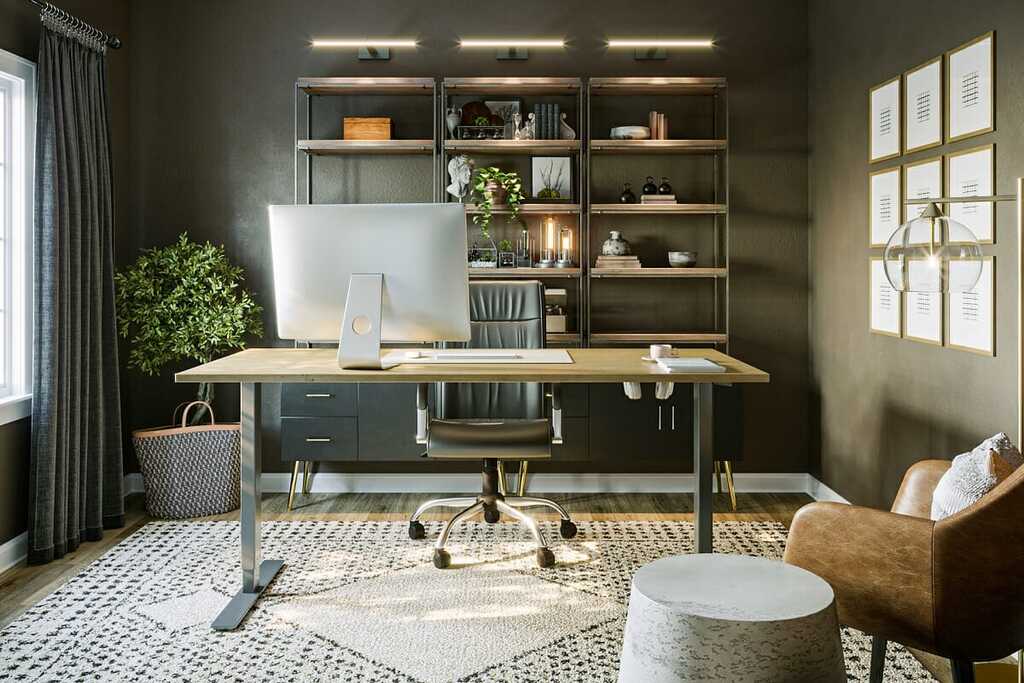Explore this post with:
With remote work becoming a permanent part of life for many, designing a custom home office is more important than ever. Whether you’re managing a business, attending virtual meetings, or simply organizing household tasks, a well-thought-out home office setup can make a big difference. From choosing the right location to incorporating ergonomic furniture, proper lighting, and smart tech, this guide covers everything you need to create a productive and personalized workspace that suits your routine and style.
1. Choose the Right Location
The location of your home office is crucial. Ideally, it should be in a quiet area with minimal distractions, away from the main living spaces. If you have the option, a room with a door that can be closed is preferable to maintain a clear boundary between work and home life. For those who need to meet clients or conduct virtual meetings, a space with a professional backdrop is essential.
2. Prioritize Natural Light
Natural light is a key element in any productive workspace. Position your desk near a window to take advantage of daylight, which can boost your mood and energy levels. If your chosen location doesn’t have ample natural light, invest in good-quality artificial lighting. When you partner with an established, award-winning custom home builder they’ll ensure there’s a combination of ambient, task, and accent lighting that creates a well-lit environment conducive to productivity.
3. Invest in Ergonomic Furniture
Comfort and ergonomics should be top priorities when selecting furniture for your home office. An ergonomic chair that supports good posture is a worthwhile investment, as it can prevent back and neck strain during long working hours. Pair this with a desk that suits your needs, whether it’s a standing desk, a traditional sit-down desk, or an adjustable one.
4. Incorporate Ample Storage Solutions
Clutter can be a significant distraction, so having adequate storage solutions is essential. Built-in shelving, cabinets, and drawers can keep your workspace organized and free from unnecessary items. Use organizers, file cabinets, and storage boxes to keep documents and supplies neatly arranged. A clean and tidy workspace can help you focus better and work more efficiently.
5. Personalize Your Space

Your home office should reflect your personality and inspire creativity. Personal touches, such as artwork, plants, and decorative items, can make the space more enjoyable and motivating. However, be mindful not to overcrowd the area with too many personal, i.e., “fun,” items, as this can lead to distraction. Choose a colour scheme that is calming and conducive to concentration; neutral tones with pops of colour can strike the right balance between a relaxing yet stimulating atmosphere.
6. Optimize Technology
Ensure your home office is built to accommodate the coming technologies, to facilitate your work into the future. Consult a specialist to advise you on equipment and setups that provide optionality.
At a basic level, don’t overlook cable management solutions to help keep cords and wires organized, and think about noise-cancelling headphones or a white noise machine to minimize auditory distractions.
7. Noise Control
Taking it a step further, you may also want to consider investing in soundproofing, which can help create a more conducive working environment. This can include installing thicker carpeting, adding soundproof curtains or blinds, and using acoustic panels on the walls. These panels can absorb sound and reduce echo, making the room quieter. If building or renovating, consider soundproof drywall or insulation to minimize noise transfer from other parts of the house.
8. Create Zones for Different Activities
If your space permits, divide your home office into zones for different activities. For example, have a primary workstation for computer work, a separate area for reading or brainstorming, and another spot for taking breaks. This zoning can help you mentally switch between tasks and maintain a more organized workflow.
9. Prioritize Air Quality and Comfort
Good air quality and a comfortable temperature are often overlooked but are vital components of a productive home office. Ensure your space is well-ventilated, and consider adding an air purifier if necessary. Temperature control is also crucial; a comfortable office environment supports better focus and efficiency.
10. Plan for Flexibility
Your needs may change over time, so designing a flexible home office is wise. Choose modular furniture that can be reconfigured as needed and leave room for potential future equipment. Flexibility in your workspace design will allow you to adapt to new projects or changes in your work routine without requiring a complete overhaul.
11. Maintain Work-Life Balance
Lastly, it’s essential to establish boundaries between work and personal life. Having a designated home office helps, but so does setting specific work hours and taking regular breaks. Ensure that your workspace is used solely for work-related activities to maintain a clear distinction between work and home life.
The Bottom Line
By following these tips, you can create a custom home office that is not only functional and efficient but also a place where you enjoy spending time. A well-designed home office can boost your productivity, enhance your comfort, and contribute to a more successful and satisfying work-from-home experience.
In Case You Missed It!
About the Author: Nishant Desai
Nishant Desai has over 8+ years of experience in SEO and blogging. His blogging expertise can organically increase online visibility and traffic for blogs and websites. With his SEO expertise, he has already contributed to iGeeksblog, Firstsportz, and Firstcuriosity. In addition, he can create content strategies, conduct keyword research, publish optimized blogs, and resolve technical issues.




